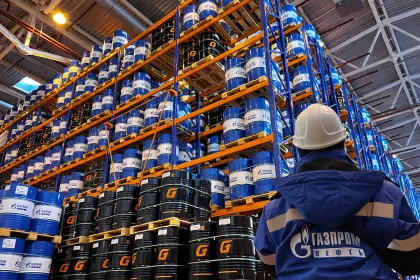A price cap on Russian oil comes into force today, Dec. 5, as western nations seek to punish the Kremlin financially for its invasion of Ukraine without upsetting already fragile global economic markets.
The move is a delicate balancing act with many moving parts that has the potential to affect countries right around the world.
This is how it will – hopefully – work…
What’s the point of it?
Countries seeking to punish Russia economically for its invasion of Ukraine face a tricky task.
The country’s oil production and the massive revenues it brings make it an obvious target, but many nations around the world rely on it and too harsh an intervention could cause devastating economic shocks.
The new price cap, agreed in a deal by EU, G7 and Australia, aims to restrict Russia’s revenue while making sure Moscow keeps supplying the global market.
How will the cap work?
The cap is due to take effect alongside an EU embargo on maritime deliveries of Russian crude oil, which comes several months after an embargo imposed by the U.S. and Canada.
Russia is the world’s second-largest crude exporter and without the cap it would be easy to find new buyers at market prices.
The measure means only oil sold at a price equal to or less than $60 per barrel can continue to be delivered. Companies based in the EU, G7 countries and Australia will be banned from providing services enabling maritime transport, such as insurance, with oil above that price.

Thermal Power Plant Hit By Missile Terror: Exclusive Footage From Kyiv Post
The G7 nations – Canada, France, Germany, Italy, Japan, the U.K. and the U.S. – provide insurance services for 90 percent of the world’s cargo and the EU is a major player in sea freight, AFP reports.
This means they should be able to pass on the cap to the majority of Russia’s customers around the world, making for a credible price cap.
If a ship flying the flag of a third country is identified carrying Russian oil at a price above the cap, Western operators will be banned from insuring and financing it for 90 days.
All countries are invited to formally join the measures. States that do not adopt them can continue to buy Russian oil above the price cap, but without using Western services to acquire, insure or transport it.
The cap will be reviewed from mid-January and then every two months, with the option to modify it according to price changes.
How will this affect Russia?
Russia will still make money from selling crude oil as the cap of $60 is well above the current cost of producing it, meaning Moscow will have an incentive to continue pumping.
Will it work?
It’s less a question of if it will work, more how effective it will be.
The market price of a barrel of Russian Urals crude is currently hovering around $65 dollars a barrel, suggesting the measure may have only a limited impact in the short term.
But in terms of the cap being adhered to and countries other than those which agreed the deal, the signs are positive so far.
“We have clear signals that a number of emerging economies, particularly in Asia, will observe the principles of the cap,” said a European official, adding that Russia is already “under pressure” from its customers to offer discounts.
It would be very complicated to find alternatives for services provided by European companies, which dominate tanker transport and insurance, the official said.
How has Russia reacted?
The Kremlin has threatened to stop deliveries of crude oil but western officials believe this won’t happen as the Kremlin would lose even more money at a time when its economy is teetering.
One European official said Russia would also remain concerned about maintaining the state of its infrastructure, which would be damaged if production is halted, and keeping the confidence of its customers, including China and India.
Russia’s response has been to warn of negative global consequences while seemingly acknowledging they can’t do much about the price cap.
“We will sell oil and oil products to countries that will work with us on market terms, even if we have to reduce production somewhat,” Russia’s Deputy Prime Minister Alexander Novak said after an OPEC+ videoconference on Sunday.
“We are currently working on mechanisms to prohibit the use of the price cap tool at any level,” Novak added, warning that the cap can only cause “further market destabilization.”
But Brussels insists the cap will help stabilize the markets and “directly benefit emerging economies and developing countries,” which will be able to get hold of Russian crude at a lower cost.
On Monday the Kremlin insisted the cap would not affect its “special military operation” in Ukraine.
Can Russia get around it?
Not easily. They could create their own fleet of tankers and insure them themselves, but Brussels believes “building a maritime ecosystem overnight will be very complicated” and such make-do measures could have trouble convincing customers.
What has Ukraine said?
Ukraine has welcomed the move but suggested on Saturday that the cap should have been set even lower, arguing that the $60 level is not enough to penalize the Kremlin.
You can also highlight the text and press Ctrl + Enter






Comments (0)